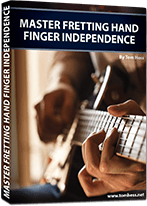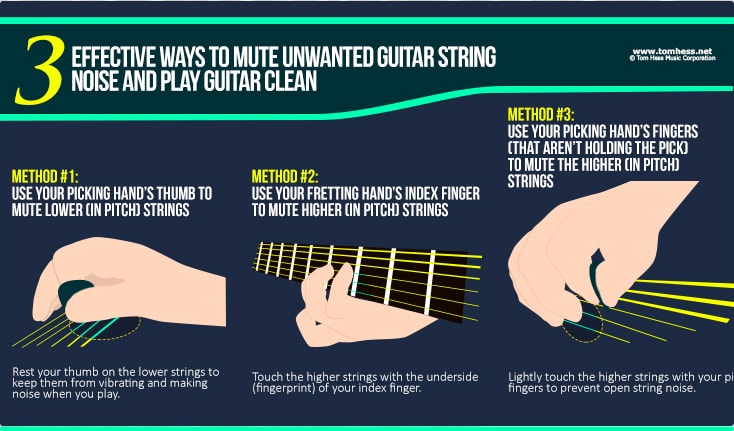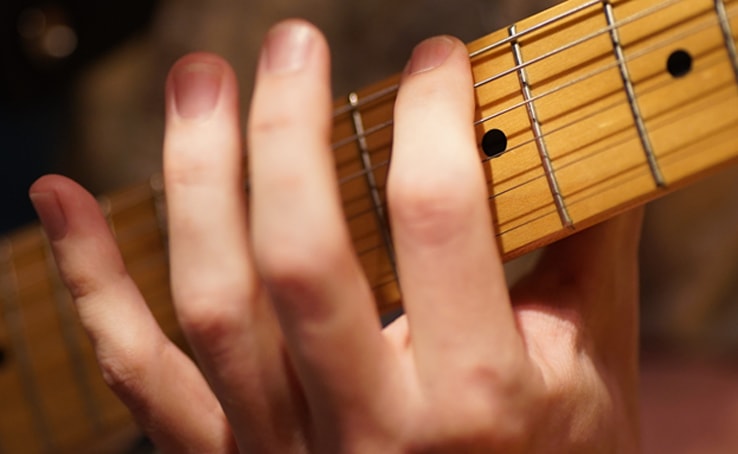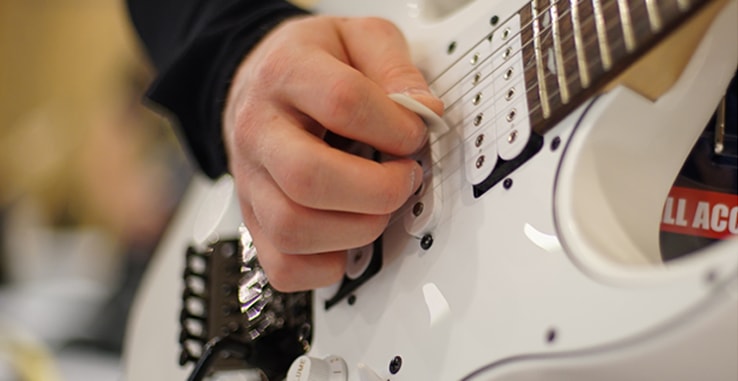Legato Technique For Guitar – How To Build Legato Speed On Guitar
by Tom Hess
Feel Incredibly Easy

EMAIL TO GET ACCESS
By submitting your info, you agree to send it to Tom Hess Music Corporation who will process and use it according to their privacy policy.
If you’d like to build your legato technique for guitar and develop pro-level guitar legato skills…
… then in this article I’ll help you build legato speed on guitar, make it cleaner and build endurance in your fretting hand.
(This way, your fingers won't get tired when you are playing legato technique at high tempos).
And no:
Mastering lead guitar legato skills has nothing to do with finger strength.
Feel Incredibly Easy

EMAIL TO GET ACCESS
By submitting your info, you agree to send it to Tom Hess Music Corporation who will process and use it according to their privacy policy.
This won’t do much to improve your lead guitar legato skills.
Developing serious guitar legato speed is about understanding 7 legato technique secrets and applying them to all your legato guitar licks.
Ready to learn how?
Watch this legato technique video to learn how to build your lead guitar legato skills:Here are a few more in-depth legato technique tips that help you master your most challenging legato guitar licks:
Excess muscle tension is the silent killer of your guitar speed.
And when it comes to your lead guitar legato skills…
… your ability to control excess tension will make or break your ability to play legato guitar licks for long periods of time without getting tired.
Why?
Simple: if you expend more energy to play notes during your legato guitar licks, you will get tired sooner. (So you will have to sacrifice your legato speed on guitar or stop playing entirely until your hands recover.)
So, how do you control excess muscle tension as you try to develop your legato guitar legato skills?
Here are a few of my favorite methods for doing that:
- Tension audit.
This is where you go through all parts of your body - one at a time – and relax tension in them as you play your legato guitar licks. For example: relax your tongue, jaw, shoulders, biceps, triceps, forearms, stomach, thighs, calves and feet.
Play one of your legato guitar licks and focus on each body part for about 10 seconds. Remember what it feels like to have it be relaxed. Then shift your focus to the next part of your body.
This is a fantastic way to develop your legato speed on guitar and sharpen your lead guitar legato skills.
Here is what it looks like:- (Brief) Exaggeration.
This technique is especially helpful for reducing tension (and giving you more guitar legato speed) after you’ve done the tension audit and found tension in specific areas of your body.
Here is how it works:
Tense up the part of the body where you notice tension to make the tension even more severe… and then relax it. This sounds strange, but it helps you relax the stubborn muscles that are staying tense no matter how hard you “try” to relax them.
- Exhale before you play any of your most challenging legato guitar licks.
This simple trick helps you to be relaxed when you have to play fast legato guitar licks having played no notes before. And it works just like it sounds. Simply exhale and start playing. You’ll be much more relaxed and you’ll get more legato speed on guitar as a result.
Question: “Tom Hess, I am doing these techniques for relaxing excess muscle tension, but I still feel some tension when I work on my lead guitar legato skills. What I should do if I want more legato speed on guitar?”
Answer: Remember that not all tension is bad. Some tension is necessary for you to even hold a guitar pick, let alone play hammer ons and pull offs during your guitar legato speed runs.
That said, focus first on relaxing the parts of your body you ‘don’t’ use to play guitar (like your feet) and relax them fully.
And if you want more specific help and feedback on your lead guitar legato skills beyond that? Take online guitar lessons.
String noise makes your legato guitar licks (and the rest of your guitar playing) sound bad, no matter how fast you play.
There are several types of excess string noise, but the main one that affects your lead guitar legato skills is: the noise that happens when open guitar strings ring out as you play other notes.
How do you mute this excess guitar string noise as you build your guitar legato speed?
Here are 3 noise-killing techniques I always use that have allowed me (and hundreds of my guitar students) to develop lead guitar legato skills and build pro-level legato speed on guitar:
1. Thumb muting.
Just as the name implies, you rest your picking hand’s thumb on the thicker strings (the lower-in-pitch strings) to mute them as you play.
The thumb literally slides up and down as you change strings during your legato guitar licks.
This has several benefits:
For one thing, it ensures that your playing is completely free of string noise (from the thicker guitar strings at least) – making your lead guitar legato skills sound more pro.
Thumb muting also helps you achieve more guitar speed in general (and build more legato speed on guitar specifically).
Here is how:
Thumb muting lets you keep the guitar pick in the trenches of the strings (space between guitar strings). This enables you to pick the strings more often (which is a big help during fast string changes in your legato guitar licks).
So, believe it or not, even the way you mute guitar strings has an impact on your legato speed o guitar.
Watch this video to see me explain thumb muting in more detail:2. Muting with the underside of your index finger.
All you do is rest your fretting hand’s index finger on the higher strings during your legato technique exercises. This helps to mute excess string noise from the strings you can’t mute with your picking hand’s thumb.
Here is what it looks like:

3. Muting with the picking hand’s fingers that aren’t holding the guitar pick.
This way of muting excess string noise won’t directly lead to ‘more’ legato speed on guitar, but it will give you yet another layer of security for making your ‘current’ guitar legato speed sound clean.
It looks like this:

What good is legato speed on guitar if you can’t use it in real-life guitar playing?
No good at all.
That’s why “integration” had better be an important part of building your lead guitar legato skills.
What’s integration?
It’s your ability to connect your musical skills together.
Check out this video to see a simple example of integration:
When it comes to your lead guitar legato skills, integration means your ability to connect legato guitar licks with other guitar licks and other guitar techniques.
For example:
Take one of the legato guitar licks you are practicing and connect it with a string bend on the high E string.
- Take one of the legato guitar licks you are practicing and connect it with a rhythm guitar riff.
- Take one of the legato guitar licks you are practicing and connect it with a scale sequence (where you have to keep your hands in perfect sync for each note).
- Take one of the legato guitar licks you are practicing and connect it with a double stop. Check out this lead guitar video for some cool double stop ideas.
Question: “Tom Hess, I find that I lose some of my guitar legato speed as I combine my lead guitar legato skills with other guitar techniques. Is this normal?”
Answer: Yes, this is totally normal. Your integration top speed will always be slower than your top speed of playing a guitar lick just once (or in isolation). That is true for ALL guitar techniques – not just your legato guitar licks.
In fact, there are several top speeds to focus on as you practice guitar (and work on your lead guitar legato skills).
This video shows you what they are:As you practice connecting your legato guitar licks with other techniques, pay attention to the final 2 notes of the first element (e.g. one of your legato guitar licks) and the first 2 notes of the second element.
This will ensure the integration happens cleanly and seamlessly.
No matter how well you focus on minimizing excess muscle tension as you work on your legato technique and develop your legato speed on guitar…
… there will come a point when your fretting hand will become tired from pushing your guitar legato speed.
So, here is a tip for developing your endurance as you work on your lead guitar legato skills:
Alternate legato playing with playing the same exercise using directional picking. Simply stop playing the lick with legato and pick every note instead.
When you switch between the 2 techniques (legato technique and directional picking), your fretting hand gets an active rest. That said, you are able to continue practicing (and play the notes of your legato guitar licks with the fretting hand) without having to stop completely.
After your fretting hand recovers – you stop picking and go back to playing the lick using hammer ons and pull offs, continuing to refine your legato speed on guitar.
This is a great way to cram more practicing into a short amount of time (and it’s especially useful on days when your practice time is limited).
Question: “But Tom Hess, I thought that alternate picking was the best way to pick on guitar? Why do you say to use directional picking when picking through legato guitar licks?”
Answer: Alternate picking is far from the “best” way to pick on guitar. It’s simply what ‘most people’ do (which doesn't make it the best). Directional picking is the far better technique for maximum guitar speed (yes, including guitar legato speed). This guitar picking article explains why.
Contrary to popular belief, “starting slowly and gradually building speed” isn’t the best way to practice for building speed in most situations. Building legato speed on guitar is no exception.
Speed bursts are one of the best ways to build guitar speed when working on your lead guitar legato skills.
What are speed bursts and how do they help you push your guitar legato speed?
 How To Increase Speed On Guitar
How To Increase Speed On GuitarDiscover the most effective ways
to increase speed in your playing.
 14 Day Guitar Speed Mini Course
14 Day Guitar Speed Mini CourseDiscover the most effective ways
to quickly build your guitar speed.
 Strengthen Your Guitar Technique
Strengthen Your Guitar TechniqueDiscover how to play with cleaner,
more accurate guitar technique.
To practice in speed bursts, set the metronome to a higher tempo than you’d normally use to play your full legato guitar licks. Then play only short fragments of your legato technique exercises. (These are the “bursts”.)
Your goal is to:
1. Play each burst only once.
2. Pause for 2-3 seconds.
3. Assess how clean the burst sounds.
When you are sure that the fragment from your legato guitar licks sound clean – make it longer. Continue until you are playing the full legato guitar licks you want to play at the new (faster speed).
Question: “Tom Hess, do speed bursts only work for legato technique and lead guitar legato skills? Or can it help me get faster with other guitar licks (not just lead guitar licks)?”
Now that you know how to improve your legato technique, let me help you master other areas of your fretting hand motions, so you can build guitar speed and play guitar at a level most other guitarists only dream about. I’ll show you how in my free eGuide: “Master Fretting Hand Finger Independence”. Download it today and discover the fretting hand technique secrets most guitarists don’t know.
 About Tom Hess: Tom Hess is a guitar teacher, music career mentor and guitar teacher trainer. He teaches rock guitar lessons online to students from all over the world and conducts instructional live guitar training events attended by musicians from over 50 countries.
About Tom Hess: Tom Hess is a guitar teacher, music career mentor and guitar teacher trainer. He teaches rock guitar lessons online to students from all over the world and conducts instructional live guitar training events attended by musicians from over 50 countries.
 | Forward this article to your friends |

